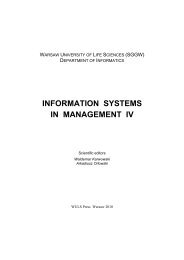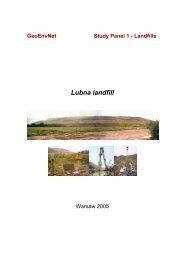ACTA SCIENTIARUM POLONORUM - SGGW
ACTA SCIENTIARUM POLONORUM - SGGW
ACTA SCIENTIARUM POLONORUM - SGGW
Create successful ePaper yourself
Turn your PDF publications into a flip-book with our unique Google optimized e-Paper software.
46 E. Majewski, P. Sulewski, M. Raggi, D. ViaggiINTRODUCTIONSince its creation, the Common Agricultural Policy (CAP) has been undergoing significanttransformations, adapting its measures and tools to the changing economy andagriculture [Majewski at all 2009]. Till the end of the 1980’s, the CAP focused strongly onmarket interventions and was successful in fulfilling its objectives as set out in the originalTreaty of Rome. However, over the years, as a consequence of increasing productivityand technological progress, pushed by price support, significant food surpluses as wellas excessive budget expenses to control supplies have been noted [Czyżewski, Stępień2009]. Due to the situation on the EU markets and external forces (e.g. GATT, later WTO)over the last 25 years the CAP has been systematically reformed. The 2003 reform movedthe CAP from production support through area payments to producer support throughdecoupled income payments in an attempt to make the farmers and the CAP more marketoriented [Commission 2010]. CAP reforms have also introduced support not only to productivefunctions of agriculture but also to other functions creating a basis for sustainabledevelopment that takes economic, social and ecological dimensions under consideration.However, previous reforms of the CAP are still considered insufficient, as it was concludedin the last mid-term health-check review [European Commission 2008a, 2008b].In addition, new challenges are emerging in the policy context, including economic crises,climate change and the growing world food needs. This is leading to proposals for furtherchanges to be introduced in the reformed CAP after 2013. The main challenges for theCAP in next years are formulated as follows [European Commission 2010]:–––,,to preserve the food production potential throughout the EU so as to guarantee longtermfood security for European citizens”;,,to support farming communities that provide the European citizens with quality anddiversity of food produced sustainably, in line with our environmental, water and animalwelfare ambitions. The active management of natural resources by farming is akey lever to maintain the rural landscape, to combat biodiversity loss and contributesto mitigating climate change”;,,to maintain viable rural communities, for whom farming is a core economic activitycreating local employment’’.New challenges to CAP require introducing adequate operational measures. However,the success of the reforms and future shape of the European Agriculture will be to a largeextent determined by the level of farmers’ adaptation to changing institutional environment.Farmers’ reactions to expected changes in the future CAP are not fully predictable.Since there still is a number of variants of the post-2013 CAP debated at present, potentialresponses of farmers can only be investigated with the use of a set of future scenarios.Considerations based on the concept of future policy scenarios are widely used in mathematicalmodels such as partial-equilibrium models CAPRI [Wieck 2003, 2006] or AG-MEMOD [Tabeau and van Leewen 2008], as well as in general equilibrium models, suchas GTAP. In many cases hypothetical scenarios are the basis for qualitative analyses inwhich specified groups of stakeholders (e.g. farmers) evaluate future results of presentedscenarios [Lobley, Butler 2010, IDEMA 2007]. In the context of CAP reforms, scenariossettings including different degrees of CAP liberalization are often found. For example,Acta Sci. Pol.
















